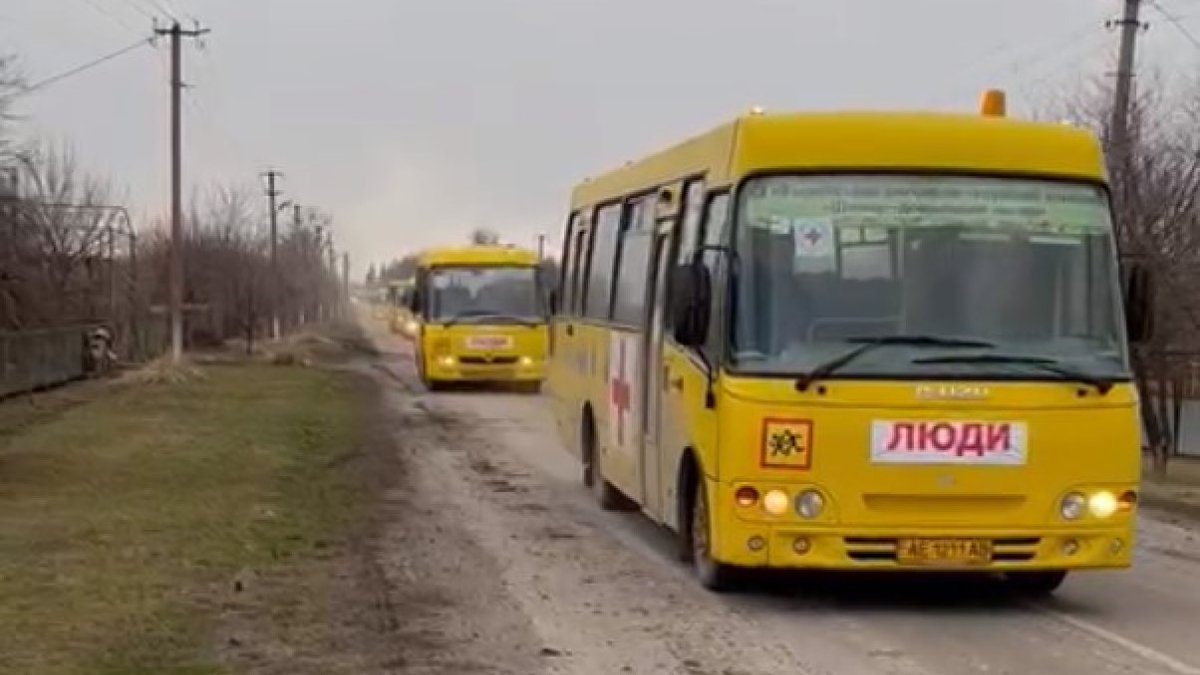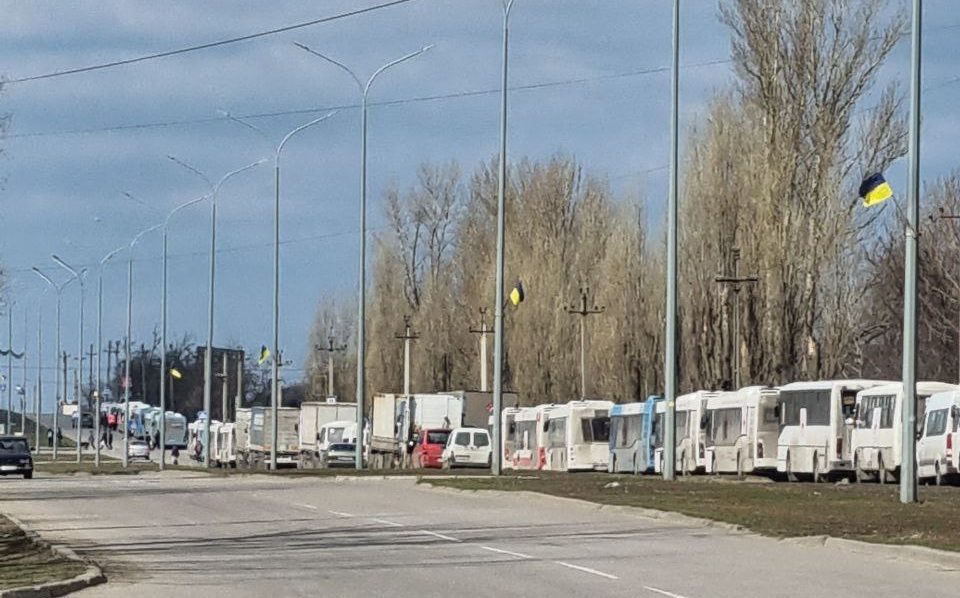Lately, Ukraine and Russia have negotiated and agreed on ceasefires to establish humanitarian corridors from occupied and besieged settlements with Russia on a daily basis. Some such corridors function as expected, others come under Russian fire, preventing the evacuation of civilians or even causing casualties among them.
- During the evacuation from the city of Irpin, Kyiv Oblast, on 6 March, Russian troops opened fire at evacuees, killing eight people, according to Irpin mayor Oleksandr Markushin.
- On 11 March, the Russian military opened fire on civilians in Bucha, Kyiv Oblast, who were waiting for evacuation, wounding one civilian.
- On the same day, an evacuation convoy from Perehoha, Kyiv Oblast, also came under fire.
According to Deputy PM Iryna Vereshchuk, on 13 March alone, Ukraine managed to evacuate more than 5,550 citizens "under constant shelling" as out of 14 agreed humanitarian corridors "only 9 actually worked."
In total, as of 14 March, almost 150,000 civilians managed to escape the war zone via the "green corridors," Ms. Vereshchuk said.
Mariupol case
The Russian troops encircled Mariupol, the port city of 430,000 people in the far southeast of Ukraine, on 2 March. Since then, the city has been constantly under Russia's massive artillery, rocket, missile, and bomb strikes. Not only was all the critical infrastructure of the city completely destroyed, but also the city's residential areas see an ongoing destruction unseen since WWII.
Thousands of Mariupol residents were killed, others have been hiding in shelters under constant shelling without running water, electricity, and often without food.
The two-week devastating siege of Mariupol has already claimed the lives of at least 2,000 civilians. The total death toll remains unknown since the bombardments and the lack of resources don't allow to find all victims under the rubble. The utility workers bury Mariupol residents in mass graves.
One of the telling examples of Russia's policies to disregard humanitarian corridors in Ukraine is the humanitarian convoy sent by the authorities of the central-Ukrainian region and city of Zaporizhzhia to Mariupol, which couldn't reach the city only 230 kilometers away for nine days in a row.
- Read also: Bombing hospitals and maternity wards in Ukraine: a brutal „innovation“ of Russian occupying forces
For more than a week, the convoy carrying food, medicines, and evacuation buses for the starving residents of the nearly fully destroyed city couldn't reach Mariupol despite agreements on the "green corridor" with Russia.
- The Zaporizhzhia authorities attempted to send the humanitarian convoy to Mariupol for the first time on 6 March, on the 11th day of the Russian invasion. The convoy consisted of eight truckloads of food and medication, and some 30 buses to evacuate women, children, elderly people from Mariupol on the way back. However, the convoy had to turn back as in the morning, the route to Mariupol came under the Russian fire from BM-21 Grad multiple rocket launchers. Meanwhile, Russian President Putin shifted the blame for the failed evacuation on Ukraine in his phone conversation with his French counterpart Emmanuel Macron, saying that “Ukrainian nationalists” prevented civilians from leaving Mariupol.
- On 7 March, the ceasefire along the humanitarian corridor between Zaporizhzhia and Mariupol was agreed upon, but, the road was mined. The Ukrainian military cleared the mines, but the Russian forces once again opened fire.
- On 8 March, the Ukrainian authorities tried to change the route in order to avoid the dangerous area, yet once again the Russian shelling disabled the delivery and evacuation. The convoy reportedly once again came under rocket fire, luckily no people were injured. Though after that the convoy went "off radars." Later it turned out that the vehicles proceeded to a safe place to wait for the route to become safe.

- Also on 8 March, Mariupol businessman Mykola Saparov tried to deliver humanitarian aid to Mariupol on his own using his mini-van, yet his car couldn't reach closer than 15 km from the city because the area was completely blocked by the Russian military.
- On 9 March, the Zaporizhzhia convoy didn't set off towards its destination as the Ukrainian officials didn't receive the Russian confirmation of their readiness for a ceasefire along the route to Mariupol.
- On 10 March, the convoy proceeded towards Mariupol, yet failed to reach its destination again.
- On the next day, there was another attempt to bring food and medicines to Marioupolites.
- on 12 March, the convoy once again moved towards the besieged city from Zaporizhzhia, on its way a Russian escort took control of the convoy and accompanied it to the occupied city of Berdiansk. There were unconfirmed reports that some aid items were looted at Russian checkpoints along the way.
- The next day the convoy started leaving Berdiansk towards Mariupol, but had to turn back to Berdiansk due to hostilities along its way.
- As of the morning of 14 March, the caravan of trucks and buses from Zaporizhzhia remained in Berdiansk. However, Ukraine's deputy PM reported that some 160 private cars managed to leave Mariupol along the green corridor and headed to occupied Berdiansk to proceed towards Zaporizhzhia.
At the time of writing this article, around 21:00 om 14 March, there were no reports on the evacuees from Mariupol reaching Zaporizhzhia or on the humanitarian convoy stuck in Berdiansk reaching Mariupol.
As Russia obliterates more and more residential areas in Ukrainian cities, it continues to hinder the evacuation of civilians from the areas it has been destroying. This only adds to the already long list of Russia's war crimes in Ukraine and once again confirms that Putin's war on Ukraine isn't a mere attempt at a land grab or installing a puppet regime in Kyiv. First of all, this is a war against Ukrainians as a people.
Update 22:50, Mar. 14:
First evacuees from Mariupol, who managed to leave their besieged city today on their cars, started to arrive in Zaporizhzhia:
First evacuated civilians arrived from Mariupol' to Zaporizhiye https://t.co/wzdTBTUTua #Ukraine pic.twitter.com/8xGP5Z4Fd9
— Liveuamap (@Liveuamap) March 14, 2022
Meanwhile, the humanitarian convoy stayed in occupied Berdiansk for another night. This is due to non-compliance with the ceasefire regime by Russian troops, the Mariupol City Council reported, adding that
"...if a green corridor is opened tomorrow and there is a ceasefire, then the humanitarian caravan will proceed to Mariupol."
The effort to deliver one single humanitarian convoy into Mariupol comes into its tenth day.
Read more:
- “I understand that this is genocide.” Oleksandr, 34, Kharkiv
- Russia escalates air strikes amid stuck land operation, Ukraine asks for air defense
- What Russians think about Russia’s war in Ukraine: video
- Russians view war in Ukraine as defensive ‘holy struggle’ of ‘us against the world’ and back Putin, Russian sociologist says
- Bombing hospitals and maternity wards in Ukraine: a brutal „innovation“ of Russian occupying forces
- Ukraine’s strategy in Russian invasion: similar to Finland’s Winter War

